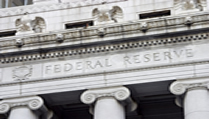 The Federal Reserve’s proposed capital rules announced Tuesday will mean shrinkage for the biggest US banks. That’s because with the capital they will be required to hold they won’t lend as much and thus won’t do as much business (in the grand scheme, of course).
The Federal Reserve’s proposed capital rules announced Tuesday will mean shrinkage for the biggest US banks. That’s because with the capital they will be required to hold they won’t lend as much and thus won’t do as much business (in the grand scheme, of course).
On Tuesday the Fed proposed a risk-based capital surcharge for the eight largest US banks or global systemically important banks (GSIBs). This means banks parking almost double the capital needed under Basel III proposals. Banks claim the surcharge plan will put them at a disadvantage to foreign competitors, who will likely closely adhere to the less stringent Basel III proposals. Whether that happens remains to be seen. However, if the intent is to make big US banks smaller, it’s a good bet they lose business to their larger foreign competitors.
The new framework will “encourage such firms to reduce their systemic footprint and lessen the threat that their failure could pose to overall financial stability,” Fed Chair Janet Yellen said in a statement.
However, the market shouldn’t worry about these smaller footprints as smaller banks not subject to the requirements can pick up the slack. “The surcharges apply only to systemically important banking organizations,” said Fed Governor Daniel Tarullo in a prepared statement. “Thus, other banks may have capacity to act as substitute providers of credit in response to any reduction in at least some forms of lending by larger banks.” He also noted that if banks shrink enough, they won’t have to pay the surcharge.
Meantime, the Fed says most of the biggest US banks already have the money set aside. “Staff estimates that almost all of the eight firms currently identified as GSIBs under the proposal would already meet their GSIB surcharges on a fully phased-in basis, and all firms are on their way to meeting their surcharges over the three-year phase-in period,” the Fed said in a statement.
The Fed will arrive at the size of the surcharge based on several factors, including a bank’s reliance on short-term funding. Basically, the more short-term funding a bank holds, the higher the surcharge. Short-term funding is at the heart of the Fed’s argument that such assets weaken a banks’ ability to survive a stress event.
As to the competition concerns, Governor Tarullo has noted that Switzerland, Sweden, and the Netherlands have each required a capital surcharge of 3 percent of risk-weighted assets in common equity tier 1 capital for their largest banks.